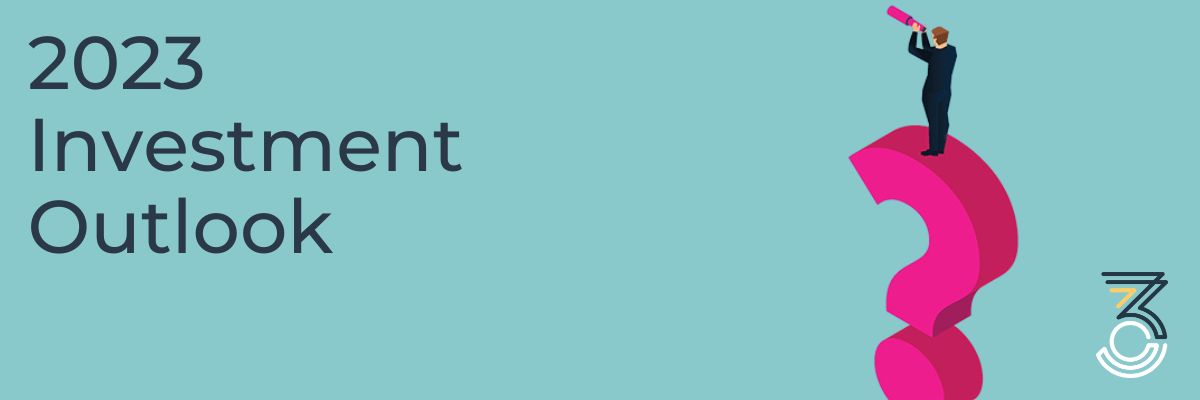2022, for investors, was one of the most dramatic in history. Against a backdrop of spiralling inflation, Central Banks in developed markets began to raise interest rates and reversed their decade long loose monetary policy, in the hope of bringing increased prices under control.
As a direct result, fixed income assets delivered the worst annual returns in living memory. In addition, we saw significant falls in equity market prices, especially in regions and sectors that had delivered outsized returns over the past 10 years, namely the United States and the tech sector.
If 2022 was the year of inflation, 2023 is the year of recession, or one with the potential for recession.
The intended consequences of interest rate hikes are to slow consumption, reduce demand and reverse inflationary pressures. However, a slowing economy and particularly one where inflation is falling from a double-digit peak, increases the risk of recession.
The questions today are, where do markets go now and how are portfolios positioned in order to reflect this?
EQUITIES
We leave 2022 and begin 2023 with a noticeable bias towards large cap value equities across our portfolios. Large cap generally refers to the stock of companies with a market capitalisation of more than $10 billion.
This served our portfolios well during 2022, with value stocks (usually classified as companies that seem to be trading below their apparent intrinsic value) significantly outperforming their growth counterparts during the year, a reversal of over 10 years of underperformance.
However, despite this outperformance over the year, value equities remain significantly undervalued against growth equities.
Value equities tend to dominate those sectors that could be considered “recession-proof” ie. defensive sectors such as utilities, energy, materials, and industrials. We believe value equities will continue to outperform growth equities throughout the year and therefore we plan to maintain our positioning towards this investment style.
What we do not expect to see is a “V-shaped” recovery in markets, akin to the post Covid lows of 2020. As Central Banks continue to tighten monetary policy, the risk of policy error rises, especially due to the threat of recession. As a result, we would expect equity markets to retest the lows of October 2022.
This combined with the anticipated slowdown in inflation, rising unemployment and declining corporate sentiment may be enough for Central Banks to consider a reversal in policy. Such a “pivot”, would result in a cut in interest rates, stimulating growth and an increase in equity market values towards the year end.
Regionally and within developed markets, the UK remains our favoured allocation due to attractive valuations and its bias to value stocks. A continued weakening dollar should provide tailwinds for emerging markets, along with the much-heralded post-Covid reopening of China. US equities, despite struggling during 2022, continue to look broadly overvalued. Our expectation is for the US to fall further as we move into a recessionary period, and company earnings are revised down.
FIXED INCOME
The “annus horribilis” of 2022 for fixed income was breath-taking. As Central Banks increased interest rates and inflation escalated, fixed income investors were caught in a perfect storm. However, with the outlook becoming more stable, the yield expansion of 2022 could mean 2023 may be a very attractive year for asset class investors.
These negative returns are rare in a diversified fixed income portfolio and has resulted in historically high yields as we enter 2023.
Furthermore, with talks of inflation peaking, the consensus is that most Central Bank interest rate hikes are done. This is a positive backdrop for fixed income and, combined with current high yields, provides an attractive entry point.
As economic growth slows and inflation abates, long term yields will fall. Although not expected to be linear, US 10-year yields are currently close to 4%, we would not be surprised if these were closer to 3% at year end.
We are cautious about taking too much credit risk in the face of slowing economic growth or recession. And, it could be argued that current yields on riskier bonds, such as high-yield bonds, are not providing extra compensation for the extra risk. Although this may change as the year progresses, for now we are choosing to remain neutral.
SUMMARY
In conclusion, volatility is likely to remain high as markets transition from a zero-interest-rate world to one with higher rates and heightened geopolitical risks.
Central Bank actions will continue to dominate portfolio positioning as they walk the fine line between inflation and recession. As such, investors need to be carefully positioned to take advantage of this.
We will continue to maintain our bias towards value equities, that provide, in our view, a fair balance between their natural dividend production and their attractive valuation. For bond investors our message is one of optimism after the falls of 2022 and we see the current high yields as very attractive.
However, as and when the market backdrop changes, so will our portfolios. Without the support of Central Banks and their ability to create liquidity without conscience, we firmly believe that the remainder of this decade will be one where opportunities will present themselves but only with activity.
The days of linear buy and hold, we believe, are over.
Please be aware that your capital will be at risk when you invest, and that you may get back less than you invested. This article does not constitute financial advice, so before acting upon it, the reader should always take the appropriate financial advice.


